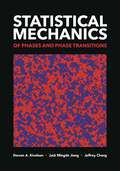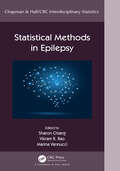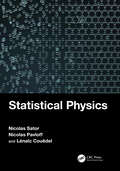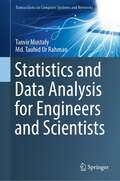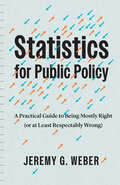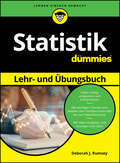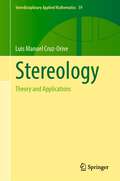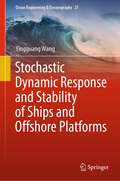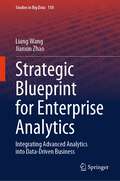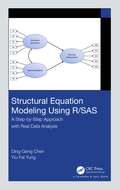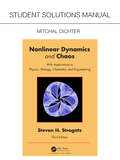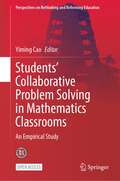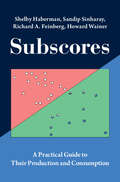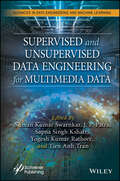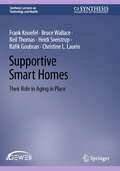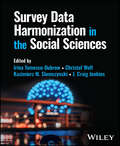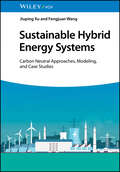- Table View
- List View
Statistical Mechanics of Phases and Phase Transitions
by Steven A. Kivelson Jack Mingde Jiang Jeffrey ChangAn engaging undergraduate introduction to the statistical mechanics of phase transitionsStatistical mechanics deploys a powerful set of mathematical approaches for studying the thermodynamic properties of complex physical systems. This textbook introduces students to the statistical mechanics of systems undergoing changes of state, focusing on the basic principles for classifying distinct thermodynamic phases and the critical phenomena associated with transitions between them. Uniquely designed to promote active learning, Statistical Mechanics of Phases and Phase Transitions presents some of the most beautiful and profound concepts in physics, enabling students to obtain an essential understanding of a computationally challenging subject without getting lost in the details.Provides a self-contained, conceptually deep introduction to the statistical mechanics of phases and phase transitions from a modern perspectiveCarefully leads students from spontaneously broken symmetries to the universality of phase transitions and the renormalization groupEncourages student-centric active learning suitable for both the classroom and self-studyFeatures a wealth of guided worksheets with full solutions throughout the book that help students learn by doingIncludes informative appendixes that cover key mathematical concepts and methodsIdeal for undergraduate physics majors and beginning graduate studentsSolutions manual for all end-of-chapter problems (available only to instructors)
Statistical Methods in Epilepsy (Chapman & Hall/CRC Interdisciplinary Statistics)
Epilepsy research promises new treatments and insights into brain function, but statistics and machine learning are paramount for extracting meaning from data and enabling discovery. Statistical Methods in Epilepsy provides a comprehensive introduction to statistical methods used in epilepsy research. Written in a clear, accessible style by leading authorities, this textbook demystifies introductory and advanced statistical methods, providing a practical roadmap that will be invaluable for learners and experts alike.Topics include a primer on version control and coding, pre-processing of imaging and electrophysiological data, hypothesis testing, generalized linear models, survival analysis, network analysis, time-series analysis, spectral analysis, spatial statistics, unsupervised and supervised learning, natural language processing, prospective trial design, pharmacokinetic and pharmacodynamic modeling, and randomized clinical trials.Features: Provides a comprehensive introduction to statistical methods employed in epilepsy research Divided into four parts: Basic Processing Methods for Data Analysis; Statistical Models for Epilepsy Data Types; Machine Learning Methods; and Clinical Studies Covers methodological and practical aspects, as well as worked-out examples with R and Python code provided in the online supplement Includes contributions by experts in the field The handbook targets clinicians, graduate students, medical students, and researchers who seek to conduct quantitative epilepsy research. The topics covered extend broadly to quantitative research in other neurological specialties and provide a valuable reference for the field of neurology.
Statistical Methods in Epilepsy (Chapman & Hall/CRC Interdisciplinary Statistics)
by Sharon Chiang Vikram R. Rao Marina VannucciEpilepsy research promises new treatments and insights into brain function, but statistics and machine learning are paramount for extracting meaning from data and enabling discovery. Statistical Methods in Epilepsy provides a comprehensive introduction to statistical methods used in epilepsy research. Written in a clear, accessible style by leading authorities, this textbook demystifies introductory and advanced statistical methods, providing a practical roadmap that will be invaluable for learners and experts alike.Topics include a primer on version control and coding, pre-processing of imaging and electrophysiological data, hypothesis testing, generalized linear models, survival analysis, network analysis, time-series analysis, spectral analysis, spatial statistics, unsupervised and supervised learning, natural language processing, prospective trial design, pharmacokinetic and pharmacodynamic modeling, and randomized clinical trials.Features: Provides a comprehensive introduction to statistical methods employed in epilepsy research Divided into four parts: Basic Processing Methods for Data Analysis; Statistical Models for Epilepsy Data Types; Machine Learning Methods; and Clinical Studies Covers methodological and practical aspects, as well as worked-out examples with R and Python code provided in the online supplement Includes contributions by experts in the field The handbook targets clinicians, graduate students, medical students, and researchers who seek to conduct quantitative epilepsy research. The topics covered extend broadly to quantitative research in other neurological specialties and provide a valuable reference for the field of neurology.
Statistical Physics
by Nicolas Sator Nicolas Pavloff Lenaic CouedelThis book presents an introduction to the main concepts of statistical physics, followed by applications to specific problems and more advanced concepts, selected for their pedagogical or practical interest. Particular attention has been devoted to the presentation of the fundamental aspects, including the foundations of statistical physics, as well as to the discussion of important physical examples. Comparison of theoretical results with the relevant experimental data (with illustrative curves) is present through the entire textbook. This aspect is facilitated by the broad range of phenomena pertaining to statistical physics, providing example issues from domains as varied as the physics of classical and quantum liquids, condensed matter, liquid crystals, magnetic systems, astrophysics, atomic and molecular physics, superconductivity and many more. This textbook is intended for graduate students (MSc and PhD) and for those teaching introductory or advanced courses on statistical physics. Key Features: A rigorous and educational approach of statistical physics illustrated with concrete examples. A clear presentation of fundamental aspects of statistical physics. Many exercises with detailed solutions. Nicolas Sator is Associate Professor at Sorbonne University, Paris, France. He is a member of the Laboratory of Theoretical Physics of Condensed Matter (LPTMC) and his research focuses on the physics of liquids. Nicolas Pavloff is Professor at Paris-Saclay University, France. He is a member of Laboratoire de Physique Théorique et Modèles Statistiques (LPTMS) and his domain of research is quantum fluid theory. Lénaïc Couëdel is Professor at the University of Sasktchewan, Saskatoon, Canada and researcher at CNRS, France. His research area is plasma physics with a focus on complex plasma crystals.
Statistical Physics
by Nicolas Sator Nicolas Pavloff Lenaic CouedelThis book presents an introduction to the main concepts of statistical physics, followed by applications to specific problems and more advanced concepts, selected for their pedagogical or practical interest. Particular attention has been devoted to the presentation of the fundamental aspects, including the foundations of statistical physics, as well as to the discussion of important physical examples. Comparison of theoretical results with the relevant experimental data (with illustrative curves) is present through the entire textbook. This aspect is facilitated by the broad range of phenomena pertaining to statistical physics, providing example issues from domains as varied as the physics of classical and quantum liquids, condensed matter, liquid crystals, magnetic systems, astrophysics, atomic and molecular physics, superconductivity and many more. This textbook is intended for graduate students (MSc and PhD) and for those teaching introductory or advanced courses on statistical physics. Key Features: A rigorous and educational approach of statistical physics illustrated with concrete examples. A clear presentation of fundamental aspects of statistical physics. Many exercises with detailed solutions. Nicolas Sator is Associate Professor at Sorbonne University, Paris, France. He is a member of the Laboratory of Theoretical Physics of Condensed Matter (LPTMC) and his research focuses on the physics of liquids. Nicolas Pavloff is Professor at Paris-Saclay University, France. He is a member of Laboratoire de Physique Théorique et Modèles Statistiques (LPTMS) and his domain of research is quantum fluid theory. Lénaïc Couëdel is Professor at the University of Sasktchewan, Saskatoon, Canada and researcher at CNRS, France. His research area is plasma physics with a focus on complex plasma crystals.
Statistics and Data Analysis for Engineers and Scientists (Transactions on Computer Systems and Networks)
by Tanvir Mustafy Md. Tauhid RahmanThis textbook summarizes the different statistical, scientific, and financial data analysis methods for users ranging from a high school level to a professional level. It aims to combine the data analysis methods using three different programs—Microsoft Excel, SPSS, and MATLAB. The book combining the different data analysis tools is a unique approach. The book presents a variety of real-life problems in data analysis and machine learning, delivering the best solution. Analysis methods presented in this book include but are not limited to, performing various algebraic and trigonometric operations, regression modeling, and correlation, as well as plotting graphs and charts to represent the results. Fundamental concepts of applied statistics are also explained here, with illustrative examples. Thus, this book presents a pioneering solution to help a wide range of students, researchers, and professionals learn data processing, interpret different findings derived from the analyses, and apply them to their research or professional fields. The book also includes worked examples of practical problems. The primary focus behind designing these examples is understanding the concepts of data analysis and how it can solve problems. The chapters include practice exercises to assist users in enhancing their skills to execute statistical analysis calculations using software instead of relying on tables for probabilities and percentiles in the present world.
Statistics for Public Policy: A Practical Guide to Being Mostly Right (or at Least Respectably Wrong)
by Jeremy G. WeberA long-overdue guide on how to use statistics to bring clarity, not confusion, to policy work. Statistics are an essential tool for making, evaluating, and improving public policy. Statistics for Public Policy is a crash course in wielding these unruly tools to bring maximum clarity to policy work. Former White House economist Jeremy G. Weber offers an accessible voice of experience for the challenges of this work, focusing on seven core practices: Thinking big-picture about the role of data in decisions Critically engaging with data by focusing on its origins, purpose, and generalizability Understanding the strengths and limits of the simple statistics that dominate most policy discussions Developing reasons for considering a number to be practically small or large Distinguishing correlation from causation and minor causes from major causes Communicating statistics so that they are seen, understood, and believed Maintaining credibility by being right (or at least respectably wrong) in every setting Statistics for Public Policy dispenses with the opacity and technical language that have long made this space impenetrable; instead, Weber offers an essential resource for all students and professionals working at the intersections of data and policy interventions. This book is all signal, no noise.
Statistics for Public Policy: A Practical Guide to Being Mostly Right (or at Least Respectably Wrong)
by Jeremy G. WeberA long-overdue guide on how to use statistics to bring clarity, not confusion, to policy work. Statistics are an essential tool for making, evaluating, and improving public policy. Statistics for Public Policy is a crash course in wielding these unruly tools to bring maximum clarity to policy work. Former White House economist Jeremy G. Weber offers an accessible voice of experience for the challenges of this work, focusing on seven core practices: Thinking big-picture about the role of data in decisions Critically engaging with data by focusing on its origins, purpose, and generalizability Understanding the strengths and limits of the simple statistics that dominate most policy discussions Developing reasons for considering a number to be practically small or large Distinguishing correlation from causation and minor causes from major causes Communicating statistics so that they are seen, understood, and believed Maintaining credibility by being right (or at least respectably wrong) in every setting Statistics for Public Policy dispenses with the opacity and technical language that have long made this space impenetrable; instead, Weber offers an essential resource for all students and professionals working at the intersections of data and policy interventions. This book is all signal, no noise.
Statistik Lehr- und Übungsbuch für Dummies (Für Dummies)
by Deborah J. RumseyIhr praktischer Einstieg in die Statistik Statistik ist nicht immer ganz einfach, aber sehr nützlich. Der Schlüssel zum Erfolg heißt: erst verstehen und dann üben, üben, üben. Deborah Rumsey erklärt Ihnen die notwendigen Grundbegriffe und erläutert die wichtigsten statistischen Konzepte. Dabei kommt sie fast ohne Formeln aus und schafft einen Bezug zwischen Theorie und Praxis. Sie lernen die verschiedenen grafischen Darstellungsmöglichkeiten von statistischem Material kennen und erfahren, wie Sie Ihre Ergebnisse richtig auswerten. Mit Übungen zu allen Themengebieten können Sie dann das erlernte Wissen festigen. Sie erfahren Wie Sie brauchbare Daten erheben Wie Sie Diagramme erstellen und interpretieren Wie Sie mit Wahrscheinlichkeitsmodellen komplizierte Fragen schnell beantworten Wie Sie einen Hypothesentest aufstellen und durchführen
Stereology: Theory and Applications (Interdisciplinary Applied Mathematics #59)
by Luis Manuel Cruz-OriveThis book presents a comprehensive set of methods for quantifying geometric quantities such as the volume of a tumor, the total surface area of the alveoli in a lung, the length of plant roots, or of blood vessels, the number of neurons in a brain compartment, the connectivity number of trabecular bone, the mean size of grains in a rock, etc.. The methods, illustrated by twenty solved case studies, are based on properly sampled slices, sections, or projections of the material, observable under light, laser, or electron microscopy, or under non-invasive radiological devices such as ecography, computed tomography, or magnetic resonance imaging. Thus, the input usually consists of flat images, and the output consists of relevant quantities defined in three dimensions. Stereology is the discipline of providing sampling designs which warrant unbiased estimation of the corresponding quantities, that is, estimation with zero mean deviation from the target. Sampling is usually systematic (i.e., with regularly spaced probes), and sparse (as opposed to reconstructions) and it is thereby efficient and easy to implement.Stereology is essentially geometric sampling, grounded on integral geometry. The necessary elements of both disciplines are detailed in textbook style, and may be used for postgraduate courses, or to serve the interest of scientists in general. Hitherto no other book on stereology has appeared which encompasses the theory, methodology, and applications of stereology in an interconnected and comprehensive way. The currently available error variance prediction formulae under systematic sampling, and their (non-obvious) derivation, are all gathered, for the first time, in the last chapter. The exposition is augmented by 127 line drawings for the theory, and 27 color pictures of real materials for the case studies.
Stochastic Dynamic Response and Stability of Ships and Offshore Platforms (Ocean Engineering & Oceanography #27)
by Yingguang WangThis textbook investigates in detail the methods for stochastic dynamic response and stability analyses of nonlinear systems (especially ships and ocean engineering systems), elucidating the advantages and disadvantages of each of the methods (the statistical linearization method, the perturbation method, the Monte Carlo Simulation method, the numerical path integration method, the global geometric method and the first passage theory). Studies on stochastic dynamic analysis of nonlinear systems have attracted engineers and scientists from various disciplines, such as aeronautical, civil, mechanical and ocean engineering. Pursuing a systematic approach, this book establishes a fundamental framework for this topic, while emphasizing the importance of accurate and efficient analysis as well as the significant influence of choosing a suitable method in the design and optimization of various nonlinear engineering systems (especially ships and ocean engineering systems).The textbook is intended for upper undergraduate and graduate students who are interested in advanced dynamic analysis technologies, researchers investigating nonlinear systems under stochastic dynamic excitations, and civil/mechanical/structural/ocean engineers working on designing and optimization of real-world nonlinear engineering systems. The basis of English translation of this book from its Chinese original manuscript was done with the help of artificial intelligence. A subsequent human revision of the content was done by the author.
Stochastic Transport in Upper Ocean Dynamics II: STUOD 2022 Workshop, London, UK, September 26–29 (Mathematics of Planet Earth #11)
by Bertrand Chapron Dan Crisan Darryl Holm Etienne Mémin Anna RadomskaThis open access proceedings volume brings selected, peer-reviewed contributions presented at the Third Stochastic Transport in Upper Ocean Dynamics (STUOD) 2022 Workshop, held virtually and in person at the Imperial College London, UK, September 26–29, 2022. The STUOD project is supported by an ERC Synergy Grant, and led by Imperial College London, the National Institute for Research in Computer Science and Automatic Control (INRIA) and the French Research Institute for Exploitation of the Sea (IFREMER). The project aims to deliver new capabilities for assessing variability and uncertainty in upper ocean dynamics. It will provide decision makers a means of quantifying the effects of local patterns of sea level rise, heat uptake, carbon storage and change of oxygen content and pH in the ocean. Its multimodal monitoring will enhance the scientific understanding of marine debris transport, tracking of oil spills and accumulation of plastic in the sea.All topics of these proceedings are essential to the scientific foundations of oceanography which has a vital role in climate science. Studies convened in this volume focus on a range of fundamental areas, including:Observations at a high resolution of upper ocean properties such as temperature, salinity, topography, wind, waves and velocity;Large scale numerical simulations;Data-based stochastic equations for upper ocean dynamics that quantify simulation error;Stochastic data assimilation to reduce uncertainty.These fundamental subjects in modern science and technology are urgently required in order to meet the challenges of climate change faced today by human society. This proceedings volume represents a lasting legacy of crucial scientific expertise to help meet this ongoing challenge, for the benefit of academics and professionals in pure and applied mathematics, computational science, data analysis, data assimilation and oceanography.
Strategic Blueprint for Enterprise Analytics: Integrating Advanced Analytics into Data-Driven Business (Studies in Big Data #150)
by Liang Wang Jianxin ZhaoThis book is a comprehensive guide for professionals, leaders, and academics seeking to unlock the power of data and analytics in the modern business landscape. It delves deeply into the strategic, architectural, and managerial aspects of implementing enterprise analytics (EA) systems in large enterprises. The book is meticulously structured into three parts. Part 1 lays the foundation for adaptable architecture in EA. Part 2 explores technical considerations: data, cloud platforms, and AI solutions. The final part focuses on strategy execution, investment, and risk management. Acting as a comprehensive guide, the book enables the creation of robust EA capabilities that foster growth, optimize operations, and keep pace with EA's dynamic world. Whether readers are leaders harnessing data's potential, practitioners navigating analytics, or academics exploring this evolving domain, this book provides insights and knowledge to guide readers toward a thriving, data-driven future.
Structural Equation Modeling Using R/SAS: A Step-by-Step Approach with Real Data Analysis
by Ding-Geng Chen Yiu-Fai YungThere has been considerable attention to making the methodologies of structural equation modeling available to researchers, practitioners, and students along with commonly used software. Structural Equation Modelling Using R/SAS aims to bring it all together to provide a concise point-of-reference for the most commonly used structural equation modeling from the fundamental level to the advanced level. This book is intended to contribute to the rapid development in structural equation modeling and its applications to real-world data. Straightforward explanations of the statistical theory and models related to structural equation models are provided, using a compilation of a variety of publicly available data, to provide an illustration of data analytics in a step-by-step fashion using commonly used statistical software of R and SAS. This book is appropriate for anyone who is interested in learning and practicing structural equation modeling, especially in using R and SAS. It is useful for applied statisticians, data scientists and practitioners, applied statistical analysts and scientists in public health, and academic researchers and graduate students in statistics, whilst also being of use to R&D professionals/practitioners in industry and governmental agencies. Key Features: Extensive compilation of commonly used structural equation models and methods from fundamental to advanced levels Straightforward explanations of the theory related to the structural equation models Compilation of a variety of publicly available data Step-by-step illustrations of data analysis using commonly used statistical software R and SAS Data and computer programs are available for readers to replicate and implement the new methods to better understand the book contents and for future applications Handbook for applied statisticians and practitioners
Structural Equation Modeling Using R/SAS: A Step-by-Step Approach with Real Data Analysis
by Ding-Geng Chen Yiu-Fai YungThere has been considerable attention to making the methodologies of structural equation modeling available to researchers, practitioners, and students along with commonly used software. Structural Equation Modelling Using R/SAS aims to bring it all together to provide a concise point-of-reference for the most commonly used structural equation modeling from the fundamental level to the advanced level. This book is intended to contribute to the rapid development in structural equation modeling and its applications to real-world data. Straightforward explanations of the statistical theory and models related to structural equation models are provided, using a compilation of a variety of publicly available data, to provide an illustration of data analytics in a step-by-step fashion using commonly used statistical software of R and SAS. This book is appropriate for anyone who is interested in learning and practicing structural equation modeling, especially in using R and SAS. It is useful for applied statisticians, data scientists and practitioners, applied statistical analysts and scientists in public health, and academic researchers and graduate students in statistics, whilst also being of use to R&D professionals/practitioners in industry and governmental agencies. Key Features: Extensive compilation of commonly used structural equation models and methods from fundamental to advanced levels Straightforward explanations of the theory related to the structural equation models Compilation of a variety of publicly available data Step-by-step illustrations of data analysis using commonly used statistical software R and SAS Data and computer programs are available for readers to replicate and implement the new methods to better understand the book contents and for future applications Handbook for applied statisticians and practitioners
Student Solutions Manual for Non Linear Dynamics and Chaos: With Applications to Physics, Biology, Chemistry, and Engineering
by Mitchal DichterThis official Student Solutions Manual includes solutions to the odd-numbered exercises featured in the third edition of Steven Strogatz's classic text Nonlinear Dynamics and Chaos: With Applications to Physics, Biology, Chemistry, and Engineering. The textbook and accompanying Student Solutions Manual are aimed at newcomers to nonlinear dynamics and chaos, especially students taking a first course in the subject. Complete with graphs and worked-out solutions, this manual demonstrates techniques for students to analyze differential equations, bifurcations, chaos, fractals, and other subjects Strogatz explores in his popular book.
Student Solutions Manual for Non Linear Dynamics and Chaos: With Applications to Physics, Biology, Chemistry, and Engineering
by Mitchal DichterThis official Student Solutions Manual includes solutions to the odd-numbered exercises featured in the third edition of Steven Strogatz's classic text Nonlinear Dynamics and Chaos: With Applications to Physics, Biology, Chemistry, and Engineering. The textbook and accompanying Student Solutions Manual are aimed at newcomers to nonlinear dynamics and chaos, especially students taking a first course in the subject. Complete with graphs and worked-out solutions, this manual demonstrates techniques for students to analyze differential equations, bifurcations, chaos, fractals, and other subjects Strogatz explores in his popular book.
Students’ Collaborative Problem Solving in Mathematics Classrooms: An Empirical Study (Perspectives on Rethinking and Reforming Education)
by Yiming CaoThis open access book provides key insights into the social fundamentals of learning and indications of social interactive modes conducive and restrictive of that learning in China. Combining theoretical and technical advances in an innovative research design, this book focuses on collaborative problem solving in mathematics to increase the visibility of social interactions in teachers’ designing, students’ learning and teachers’ instructional intervention. It also explores students’ cognitive and social interaction as well as teacher intervention in students’ group collaboration.
Subscores: A Practical Guide to Their Production and Consumption
by null Shelby Haberman null Sandip Sinharay null Richard A. Feinberg null Howard WainerThis authoritative guide directs consumers and users of test scores on when and how to provide subscores and how to make informed decisions based on them. The book is designed to be accessible to practitioners and score users with varying levels of technical expertise, from executives of testing organizations and students who take tests to graduate students in educational measurement, psychometricians, and test developers. The theoretical background required to evaluate subscores and improve them are provided alongside examples of tests with subscores to illustrate their use and misuse. The first chapter covers the history of tests, subtests, scores, and subscores. Later chapters go into subscore reporting, evaluating and improving the quality of subscores, and alternatives to subscores when they are not appropriate. This thorough introduction to the existing research and best practices will be useful to graduate students, researchers, and practitioners.
Supervised and Unsupervised Data Engineering for Multimedia Data
by Suman Kumar Swarnkar J. P. Patra Sapna Singh Kshatri Yogesh Kumar Rathore Tien Anh TranSUPERVISED and UNSUPERVISED DATA ENGINEERING for MULTIMEDIA DATA Explore the cutting-edge realms of data engineering in multimedia with Supervised and Unsupervised Data Engineering for Multimedia Data, where expert contributors delve into innovative methodologies, offering invaluable insights to empower both novices and seasoned professionals in mastering the art of manipulating multimedia data with precision and efficiency. Supervised and Unsupervised Data Engineering for Multimedia Data presents a groundbreaking exploration into the intricacies of handling multimedia data through the lenses of both supervised and unsupervised data engineering. Authored by a team of accomplished experts in the field, this comprehensive volume serves as a go-to resource for data scientists, computer scientists, and researchers seeking a profound understanding of cutting-edge methodologies. The book seamlessly integrates theoretical foundations with practical applications, offering a cohesive framework for navigating the complexities of multimedia data. Readers will delve into a spectrum of topics, including artificial intelligence, machine learning, and data analysis, all tailored to the challenges and opportunities presented by multimedia datasets. From foundational principles to advanced techniques, each chapter provides valuable insights, making this book an essential guide for academia and industry professionals alike. Whether you’re a seasoned practitioner or a newcomer to the field, Supervised and Unsupervised Data Engineering for Multimedia Data illuminates the path toward mastery in manipulating and extracting meaningful insights from multimedia data in the modern age.
Supervised and Unsupervised Data Engineering for Multimedia Data
by Suman Kumar Swarnkar J P Patra Sapna Singh Kshatri Yogesh Kumar Rathore Tien Anh TranSUPERVISED and UNSUPERVISED DATA ENGINEERING for MULTIMEDIA DATA Explore the cutting-edge realms of data engineering in multimedia with Supervised and Unsupervised Data Engineering for Multimedia Data, where expert contributors delve into innovative methodologies, offering invaluable insights to empower both novices and seasoned professionals in mastering the art of manipulating multimedia data with precision and efficiency. Supervised and Unsupervised Data Engineering for Multimedia Data presents a groundbreaking exploration into the intricacies of handling multimedia data through the lenses of both supervised and unsupervised data engineering. Authored by a team of accomplished experts in the field, this comprehensive volume serves as a go-to resource for data scientists, computer scientists, and researchers seeking a profound understanding of cutting-edge methodologies. The book seamlessly integrates theoretical foundations with practical applications, offering a cohesive framework for navigating the complexities of multimedia data. Readers will delve into a spectrum of topics, including artificial intelligence, machine learning, and data analysis, all tailored to the challenges and opportunities presented by multimedia datasets. From foundational principles to advanced techniques, each chapter provides valuable insights, making this book an essential guide for academia and industry professionals alike. Whether you’re a seasoned practitioner or a newcomer to the field, Supervised and Unsupervised Data Engineering for Multimedia Data illuminates the path toward mastery in manipulating and extracting meaningful insights from multimedia data in the modern age.
Supportive Smart Homes: Their Role in Aging in Place (Synthesis Lectures on Technology and Health)
by Frank Knoefel Bruce Wallace Neil Thomas Heidi Sveistrup Rafik Goubran Christine L. LaurinSignificant health-industry human resource needs increase the reliance on family and friends to support older adults hoping to age in place. This book explores how recent improvements in integrated home technologies have the potential to address those challenges. The book considers how embedded home sensors can be used to monitor the health and wellbeing of older adults and how that can be used to assist with supporting safety and well-being. The content is designed to help multiple stakeholders in the supportive smart home space to better understand the complexity of this field and the need for transdisciplinary collaboration. These stakeholders include the older adults who will benefit from supportive smart home technology; informal and formal caregiver and healthcare professionals concerned about the older adult’s well-being; researchers from multiple disciplines in the supportive smart home area and their funders; companies looking to develop solutions and services or expand their offerings; policy makers who want to ensure privacy and equity in access and a successful integration of these technologies into the evolving health and social services sectors; and students, the future leaders in AgeTech. Overall, the intent of the book is to inspire engineers, computer scientists, industrial designers, clinicians and healthcare providers, social scientists, students, policy makers, and older adults and their caregivers to collaborate in advancing the supportive smart home space to develop more options for aging in place.
Survey Data Harmonization in the Social Sciences
by Irina Tomescu-Dubrow Christof Wolf Kazimierz M. Slomczynski J. Craig JenkinsSurvey Data Harmonization in the Social Sciences An expansive and incisive overview of the practical uses of harmonization and its implications for data quality and costs In Survey Data Harmonization in the Social Sciences, a team of distinguished social science researchers delivers a comprehensive collection of ex-ante and ex-post harmonization methodologies in the context of specific longitudinal and cross-national survey projects. The book examines how ex-ante and ex-post harmonization work individually and in relation to one another, offering practical guidance on harmonization decisions in the preparation of new data infrastructure for comparative research. Contributions from experts in sociology, political science, demography, economics, health, and medicine are included, all of which give voice to discipline-specific and interdisciplinary views on methodological challenges inherent in harmonization. The authors offer perspectives from Europe and the United States, as well as Africa, the latter of which provides insights rarely featured in survey research methodology handbooks. Readers will also find: A thorough introduction to approaches and concepts for survey data harmonization, as well as the effects of data harmonization on the overall survey research process Comprehensive explorations of ex-ante harmonization of survey instruments and non-survey data Practical discussions of ex-post harmonization of national social surveys, census and time use data, including explorations of survey data recycling A detailed overview of statistical issues linked to the use of harmonized survey data Perfect for upper undergraduate and graduate researchers who specialize in survey methodology, Survey Data Harmonization in the Social Sciences will also earn a place in the libraries of survey practitioners who engage in international research.
Survey Data Harmonization in the Social Sciences
by Irina Tomescu‐Dubrow Christof Wolf Kazimierz M. Slomczynski J. Craig JenkinsSurvey Data Harmonization in the Social Sciences An expansive and incisive overview of the practical uses of harmonization and its implications for data quality and costs In Survey Data Harmonization in the Social Sciences, a team of distinguished social science researchers delivers a comprehensive collection of ex-ante and ex-post harmonization methodologies in the context of specific longitudinal and cross-national survey projects. The book examines how ex-ante and ex-post harmonization work individually and in relation to one another, offering practical guidance on harmonization decisions in the preparation of new data infrastructure for comparative research. Contributions from experts in sociology, political science, demography, economics, health, and medicine are included, all of which give voice to discipline-specific and interdisciplinary views on methodological challenges inherent in harmonization. The authors offer perspectives from Europe and the United States, as well as Africa, the latter of which provides insights rarely featured in survey research methodology handbooks. Readers will also find: A thorough introduction to approaches and concepts for survey data harmonization, as well as the effects of data harmonization on the overall survey research process Comprehensive explorations of ex-ante harmonization of survey instruments and non-survey data Practical discussions of ex-post harmonization of national social surveys, census and time use data, including explorations of survey data recycling A detailed overview of statistical issues linked to the use of harmonized survey data Perfect for upper undergraduate and graduate researchers who specialize in survey methodology, Survey Data Harmonization in the Social Sciences will also earn a place in the libraries of survey practitioners who engage in international research.
Sustainable Hybrid Energy Systems: Carbon Neutral Approaches, Modeling, and Case Studies
by Jiuping Xu Fengjuan WangSustainable Hybrid Energy Systems Discovering comprehensive approaches to build sustainable hybrid energy systems Hybridization is the eternal theme of human energy utilization. However, it has never been more important than it is now because of the urgency of promoting energy transition and achieving carbon neutrality. Therefore, exploring the design, combustion, operation, and policy challenges of sustainable hybrid energy systems becomes increasingly important. Sustainable Hybrid Energy Systems: Carbon Neutral Approaches, Modeling, and Case Studies provides a detailed explanation of these aspects. Dividing hybrid energy systems into three categories—co-located, co-combusted, and co-operated, this book emphasizes the deployment optimization, emission quota allocation, scheduling coordination, and renewable portfolio standards implementation of these systems. The results are essential tools for understanding the current and future of multi-input single-output hybrid energy systems. Sustainable Hybrid Energy Systems readers will also find: Clear logical framework that reveals the constitutes of hybrid energy systems.Systematic technical scheme for building an economic, environmental, flexible, and resilient future energy system.Extensive case studies from single power plant level, multiple power plant level, and grid level.Effective guidelines for wider application of the proposed carbon neutral approaches. Sustainable Hybrid Energy Systems is ideal for power engineers, electrical engineers, scientists in industry, and environmental researchers looking to understand these energy solutions. It will also provide collectible value for libraries.
